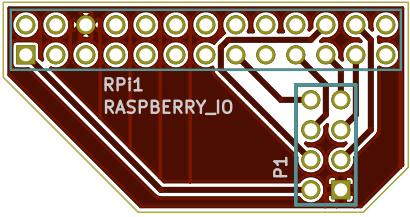Moderator: Unterschied zwischen den Versionen
Anlumo (Diskussion | Beiträge) K formatting |
Anlumo (Diskussion | Beiträge) new MCU |
||
| Zeile 10: | Zeile 10: | ||
===MCU=== | ===MCU=== | ||
[http://www.st.com/web/ | [http://www.st.com/st-web-ui/static/active/en/resource/technical/document/datasheet/DM00088500.pdf STM32F030F4P6] | ||
Reasons: | Reasons: | ||
* Cheap | * Cheap (€.9 at 10+ pieces) | ||
* Powerful (up to 24MHz), Cortex- | * Powerful (up to 24MHz), Cortex-M0 | ||
* | * Built-in clock adequate | ||
* | * Easy to use package (TSSOP20) | ||
* 3.3V levels | * 3.3V levels | ||
[http://at.mouser.com/ProductDetail/STMicroelectronics/STM32F030F4P6/?qs=%2fha2pyFadujR%2fWSfahMbfiqiWxswwapRJ1bzZ2a6qLp0xVcIZiSvQA%3d%3d Mouser-Link] | |||
Four caps needed: 100nF+4.7µF for VDD, 10nF+1µF for VDDA. | |||
Alternatives: | Alternatives: | ||
* | * STM32F100C8 (faster, a bit more expensive) | ||
* Freescale Cortex-M0 | * Freescale Cortex-M0 | ||
* MSP430G2553 | * MSP430G2553 | ||
Aktuelle Version vom 18. Februar 2014, 01:02 Uhr
What
A voting device, similar to edubuzzer but with the design-goal of being super-cheap.
Hardware
bare PCB, no container (yet)
MCU
Reasons:
- Cheap (€.9 at 10+ pieces)
- Powerful (up to 24MHz), Cortex-M0
- Built-in clock adequate
- Easy to use package (TSSOP20)
- 3.3V levels
Four caps needed: 100nF+4.7µF for VDD, 10nF+1µF for VDDA.
Alternatives:
- STM32F100C8 (faster, a bit more expensive)
- Freescale Cortex-M0
- MSP430G2553
- RFD22301 (probably far too expensive, but it includes the RF stuff)
- ATmega328P @ 3.3V, 8MHz
RF
some info for using them with Arduinos
Reasons:
- Cheap
- Small
- Relatively low-power
- Easy to use
- Lot of libraries for it
- Supports point-to-point, broadcasts and multiple channels
- Special module versions available with ranges of up to 1100m
- Uses 3.3V levels
There are a lot of modules with that chip available. Most of them use a 2x4pin 0.1" connector with a standard pinout. There are also much smaller SMD modules available, but these are more expensive and do not seem to have a standard pinout or layout.
Alternatives:
- Bluetooth 4.0 Low Energy (nRF8001, BLE113-A, CC2541, …)
- 433MHz RF wireless transmitter module (one-way only!)
- 802.11b/g/n (CC3000, HF-LPB, …)
Display?
Nokia 5110 display
Reasons:
- Cheap
- Small
- Low-power
- Lot of libraries for it
- Can mount directly to the PCB, no expensive/rare connector required
- Uses 3.3V levels
Alternatives:
- Just some status LEDs (takes a lot of power)
- Sharp Memory Display
- Liquid Crystal display without a backlight
- Two flipdot-dots?
Buttons
5x5mm button
Reasons:
- Cheap
- Large enough for humans to handle
Alternatives:
too many to list
Leds
None
Reasons:
- LEDs require a lot of power
- Not a lot of expressiveness with them
Power
Coin Cell: CR2032, 3V
Reasons:
- Cheap
- Low self-discharge
Unsolved problems:
- Does not deliver a lot of power (~0.1mA per spec)
- Not a lot of capacity
Alternatives:
- AA battery (large, but cheap and easily available — only delivers 1-1.5V though)
- 2xAA battery for 2-3V (very large!)
- Lithium Polymer Battery (like the one used in the Magic Shifter)
- Solar Panel
Other Stuff
BOM
Table here..
Basestation
RaspberryPi
NRF shield

Who
Overflo
anlumo
